High Resolution Chemistry Transport Modeling with the On-Line CHIMERE-WRF Model over the French Alps—Analysis of a Feedback of Surface Particulate Matter Concentrations on Mountain Meteorology
Abstract
:1. Introduction
- Evaluate the ability of the CHIMERE-WRF coupled model to capture the high recorded pollutant concentrations,
- Analyze the effect of the horizontal resolution on model results,
- Evaluate the effect of the on-line coupling on a short period at very local scale,
- Evaluate the effect of less usual WRF settings (based on previous findings in the literature) on model results,
- Analyze the transport of pollutants under winter conditions in Alpine valleys up to the glaciers through the wet and dry deposition processes.
2. Method
2.1. Model Set-Up
2.2. Domains
2.3. Period
- 19–20 November (≈20–40 mm),
- 29–30 November (≈2–3 mm),
- 19–22 December (≈10–20 mm).
2.4. Observations
2.5. Numerical Experiments
3. Results and Discussion
3.1. Evaluation of the Meteorology
3.2. Chemical Compounds Concentrations
3.3. Impact of the On-Line Coupling
- (i)
- Due to a change of concentrations and the direct effect on the radiative budget, temperature and wind speed are slightly modified at the bottom of the valley but sufficiently to initiate a perturbation of wind regimes in the vicinity.
- (ii)
- The change of the integrated PM2.5 concentrations over the domain between CPL02 and CPL01 ranges on average from 5.5 % to 0.3 % for “Plain” and “Altitude” sites, respectively. Altitude refers to surface pressures below 750 hPa and Plain for surface pressures above 900 hPa.
- (iii)
- The gradient of water vapor mixing ratio (QVAPOR variable in WRF) is rather high in steep areas, then the total column of water vapor can strongly fluctuate from cell to cell in the model.
- (iv)
- Water vapor as a radiative forcer contributes significantly to the greenhouse effect, between 35% and 65% for clear sky conditions and between 65% and 85% for a cloudy day. Water vapor concentration fluctuates regionally and locally as shown in Figure S8. [74]. At night the long-wave radiation is one of the most important variable governing the radiative budget, a change of water mixing ratio initiated in the bottom of the valley by small motions immediately modifies the radiative balance.
- (v)
- Over altitude areas nearby the valley, the albedo is generally high about 0.6 compared to 0.25 in the valley. A higher albedo amplifies this effect on the radiative budget with a higher long-wave radiation emitted from the ground, involving modifications of temperature and then enhancing the modifications of local wind regimes and temperatures.
- (vi)
- Under anticyclonic conditions, when the sun rises, the short-wave radiation becomes dominant in the radiative budget and the perturbations due to long-wave radiation slightly disappears but can reappear after the sunset.
3.4. Impact of WRF Configurations
3.5. Transport of Air Pollutants
4. Conclusions
Supplementary Materials
Author Contributions
Funding
Acknowledgments
Conflicts of Interest
Abbreviations
| BOUN | Boundary Conditions |
| CARA | On-Going French Program to Monitor the Aerosol Composition |
| CCN | Cloud Condensation Nuclei |
| CH | Switzerland code ISO 3166-2 |
| CHIMERE | National French CTM |
| Cor | Correlation |
| CTM | Chemistry Transport Model |
| DECOMBIO | Deconvolution de la contribution de la combustion de la biomasse aux particules dans la vallée de l’Arve |
| EC | Elemental Carbon |
| EPI | Episode I |
| EPII | Episode II |
| EU | European Union |
| EMEP | European Monitoring and Evaluation Programme |
| FR | France code ISO 3166-2 |
| GFS | Global Forecasting System |
| GOCART | Goddard Chemistry Aerosol Radiation and Transport |
| INIT | Initialization Conditions |
| IT | Italy code ISO 3166-2 |
| IVOC | intermediate-volatile organic compound |
| LMD | Laboratoire de Météorologie Dynamique |
| LMDzINCA | Global Chemistry Tranport Model developped at LMD |
| LWC | Liquid Water Content |
| LWUPT | instantaneous upwelling longwave flux at the top (from WRF) |
| MB | Mean Bias |
| MODIS | Moderate-Resolution Imaging Spectroradiometer |
| MOS | Monin-Obukhov Similarity scheme |
| MYJ | Mellor-Yamada-Janjic (Eta) TKE scheme |
| NCEP | National Centers for Environmental Prediction |
| NCO | netCDF Operator |
| NMVOC | Non Methane Volatil Organic Compound |
| OC | Organic Carbon |
| OM | Organic Matter |
| OMwb | Organic Matter from wood burning |
| PBL | Planetary Boundary Layer |
| PBLH | Planetary Boundary Layer height |
| PM | Particulate Matter |
| PM10 | Particulate Matter up to 10 micrometers in diameter |
| PM2.5 | Particulate Matter up to 2.5 micrometers in diameter |
| PPM2.5 | Primary PM2.5 |
| PPMcoarse | Primary Coarse PM |
| POA | Primary Organic Aerosol |
| QVAPOR | Water vapor mixing ratio (in WRF) |
| RH | Relative humidity |
| RMSE | Root Mean Square Error |
| RRTMG | Rapid Radiative Transfer Model for Global Climate Models |
| SLCP | short-lived climate pollutant |
| SOA | Secondary Organic Aerosol |
| SPD | 10 m wind speed |
| SVOC | Semi-volatile organic compound |
| SWDOWN | downward short wave flux at ground (from WRF) |
| TMP | 2 m Temperature |
| WRF | Weather Research and Forecasting model |
| YSU | Yonsei University |
Appendix A. Error Statistics
Appendix B. Averaging and Cumulating Computation
- P < 750 hPa for Altitude areas
- P > 900 hPa for Plain areas
References
- Faustini, A.; Rapp, R.; Forastiere, F. Nitrogen dioxide and mortality: Review and meta-analysis of long-term studies. Eur. Respir. J. 2014, 44, 744–753. [Google Scholar] [CrossRef] [PubMed] [Green Version]
- Di, Q.; Wang, Y.; Zanobetti, A.; Wang, Y.; Koutrakis, P.; Choirat, C.; Dominici, F.; Schwartz, J.D. Air Pollution and Mortality in the Medicare Population. N. Engl. J. Med. 2017, 376, 2513–2522. [Google Scholar] [CrossRef] [PubMed]
- Kanakidou, M.; Seinfeld, J.H.; Pandis, S.N.; Barnes, I.; Dentener, F.J.; Facchini, M.C.; Van Dingenen, R.; Ervens, B.; Nenes, A.; Nielsen, C.J.; et al. Organic aerosol and global climate modelling: A review. Atmos. Chem. Phys. 2005, 5, 1053–1123. [Google Scholar] [CrossRef] [Green Version]
- Cohen, A.J.; Brauer, M.; Burnett, R.; Anderson, H.R.; Frostad, J.; Estep, K.; Balakrishnan, K.; Brunekreef, B.; Dandona, L.; Dandona, R.; et al. Estimates and 25-year trends of the global burden of disease attributable to ambient air pollution: An analysis of data from the Global Burden of Diseases Study 2015. Lancet 2017, 389, 1907–1918. [Google Scholar] [CrossRef] [Green Version]
- Bergin, M.H.; Ghoroi, C.; Dixit, D.; Schauer, J.J.; Shindell, D.T. Large Reductions in Solar Energy Production Due to Dust and Particulate Air Pollution. Environ. Sci. Technol. Lett. 2017, 4, 339–344. [Google Scholar] [CrossRef] [Green Version]
- Lin, L.; Xu, Y.; Wang, Z.; Diao, C.; Dong, W.; Xie, S.P. Changes in Extreme Rainfall Over India and China Attributed to Regional Aerosol-Cloud Interaction During the Late 20th Century Rapid Industrialization. Geophys. Res. Lett. 2018, 45, 7857–7865. [Google Scholar] [CrossRef] [Green Version]
- Schraufnagel, D.E.; Balmes, J.R.; Cowl, C.T.; De Matteis, S.; Jung, S.H.; Mortimer, K.; Perez-Padilla, R.; Rice, M.B.; Riojas-Rodriguez, H.; Sood, A.; et al. Air Pollution and Noncommunicable Diseases: A Review by the Forum of International Respiratory Societies; Environmental Committee, Part 1: The Damaging Effects of Air Pollution. CHEST 2019, 155, 409–416. [Google Scholar] [CrossRef] [Green Version]
- Tang, S.; Yan, Q.; Shi, W.; Wang, X.; Sun, X.; Yu, P.; Wu, J.; Xiao, Y. Measuring the impact of air pollution on respiratory infection risk in China. Environ. Pollut. 2018, 232, 477–486. [Google Scholar] [CrossRef]
- Mailler, S.; Menut, L.; Khvorostyanov, D.; Valari, M.; Couvidat, F.; Siour, G.; Turquety, S.; Briant, R.; Tuccella, P.; Bessagnet, B.; et al. CHIMERE-2017: From urban to hemispheric chemistry-transport modeling. Geosci. Model Dev. 2017, 10, 2397–2423. [Google Scholar] [CrossRef] [Green Version]
- Rouïl, L.; Honoré, C.; Vautard, R.; Beekmann, M.; Bessagnet, B.; Malherbe, L.; Meleux, F.; Dufour, A.; Elichegaray, C.; Flaud, J.; et al. PREV’AIR: An operational forecasting and mapping system for air quality in Europe. BAMS 2009, 90, 73–83. [Google Scholar] [CrossRef] [Green Version]
- Vieno, M.; Heal, M.; Twigg, M.; MacKenzie, I.; Braban, C.; Lingard, J.; Ritchie, S.; Beck, R.; Móring, A.; Ots, R.; et al. The UK particulate matter air pollution episode of March-April 2014: More than Saharan dust. Environ. Res. Lett. 2016, 11, 1–12. [Google Scholar] [CrossRef]
- Bessagnet, B.; Hodzic, A.; Blanchard, O.; Lattuati, M.; Bihan, O.L.; Marfaing, H.; Rouïl, L. Origin of particulate matter pollution episodes in wintertime over the Paris Basin. Atmos. Environ. 2005, 39, 6159–6174. [Google Scholar] [CrossRef]
- Petit, J.E.; Amodeo, T.; Meleux, F.; Bessagnet, B.; Menut, L.; Grenier, D.; Pellan, Y.; Ockler, A.; Rocq, B.; Gros, V.; et al. Characterising an intense PM pollution episode in March 2015 in France from multi-site approach and near real time data: Climatology, variabilities, geographical origins and model evaluation. Atmos. Environ. 2017, 155, 68–84. [Google Scholar] [CrossRef]
- Skamarock, W.C.; Klemp, J.B.; Dudhia, J.; Gill, D.O.; Barker, D.M.; Duda, M.; Huang, X.; Wang, W.; Powers, J.G. A description of the Advanced Research WRF Version 3. NCAR Tech. Note 2008, 1–125. [Google Scholar] [CrossRef]
- Wilson, T.H.; Fovell, R.G. Modeling the Evolution and Life Cycle of Stable Cold Pools. Weather Forecast. 2016, 31, 1753–1769. [Google Scholar] [CrossRef]
- Wilson, T.H.; Fovell, R.G. Modeling the Evolution and Life Cycle of Radiative Cold Pools and Fog. Weather Forecast. 2018, 33, 203–220. [Google Scholar] [CrossRef]
- Gohm, A.; Harnisch, F.; Vergeiner, J.; Obleitner, F.; Schnitzhofer, R.; Hansel, A.; Fix, A.; Neininger, B.; Emeis, S.; Schäfer, K. Air Pollution Transport in an Alpine Valley: Results From Airborne and Ground-Based Observations. Bound.-Layer Meteorol. 2009, 131, 441–463. [Google Scholar] [CrossRef] [Green Version]
- Ritter, M.; Müller, M.D.; Tsai, M.Y.; Parlow, E. Air pollution modeling over very complex terrain: An evaluation of WRF-Chem over Switzerland for two 1-year periods. Atmos. Res. 2013, 132–133, 209–222. [Google Scholar] [CrossRef]
- Mues, A.; Lauer, A.; Lupascu, A.; Rupakheti, M.; Kuik, F.; Lawrence, M.G. WRF and WRF-Chem v3.5.1 simulations of meteorology and black carbon concentrations in the Kathmandu Valley. Geosci. Model Dev. 2018, 11, 2067–2091. [Google Scholar] [CrossRef] [Green Version]
- Quimbayo-Duarte, J.; Staquet, C.; Chemel, C.; Arduini, G. Impact of Along-Valley Orographic Variations on the Dispersion of Passive Tracers in a Stable Atmosphere. Atmosphere 2019, 10, 225. [Google Scholar] [CrossRef] [Green Version]
- Quimbayo-Duarte, J.; Staquet, C.; Chemel, C.; Arduini, G. Dispersion of Tracers in the Stable Atmosphere of a Valley Opening onto a Plain. Bound.-Layer Meteorol. 2019, 172, 291–315. [Google Scholar] [CrossRef]
- Sand, M.; Berntsen, T.K.; von Salzen, K.; Flanner, M.G.; Langner, J.; Victor, D.G. Response of Arctic temperature to changes in emissions of short-lived climate forcers. Nat. Clim. Chang. 2016, 6, 286–289. [Google Scholar] [CrossRef]
- Schacht, J.; Heinold, B.; Quaas, J.; Backman, J.; Cherian, R.; Ehrlich, A.; Herber, A.; Huang, W.T.K.; Kondo, Y.; Massling, A.; et al. The importance of the representation of air pollution emissions for the modeled distribution and radiative effects of black carbon in the Arctic. Atmos. Chem. Phys. 2019, 19, 11159–11183. [Google Scholar] [CrossRef] [Green Version]
- Briant, R.; Tuccella, P.; Deroubaix, A.; Khvorostyanov, D.; Menut, L.; Mailler, S.; Turquety, S. Aerosol–radiation interaction modelling using online coupling between the WRF 3.7.1 meteorological model and the CHIMERE 2016 chemistry-transport model, through the OASIS3-MCT coupler. Geosci. Model Dev. 2017, 10, 927–944. [Google Scholar] [CrossRef] [Green Version]
- Tuccella, P.; Menut, L.; Briant, R.; Deroubaix, A.; Khvorostyanov, D.; Mailler, S.; Siour, G.; Turquety, S. Implementation of Aerosol-Cloud Interaction within WRF-CHIMERE Online Coupled Model: Evaluation and Investigation of the Indirect Radiative Effect from Anthropogenic Emission Reduction on the Benelux Union. Atmosphere 2019, 10, 20. [Google Scholar] [CrossRef] [Green Version]
- Couvidat, F.; Bessagnet, B.; Garcia-Vivanco, M.; Real, E.; Menut, L.; Colette, A. Development of an inorganic and organic aerosol model (CHIMERE 2017β v1.0): Seasonal and spatial evaluation over Europe. Geosci. Model Dev. 2018, 11, 165–194. [Google Scholar] [CrossRef] [Green Version]
- Menut, L.; Tuccella, P.; Flamant, C.; Deroubaix, A.; Gaetani, M. The role of aerosol–radiation–cloud interactions in linking anthropogenic pollution over southern west Africa and dust emission over the Sahara. Atmos. Chem. Phys. 2019, 19, 14657–14676. [Google Scholar] [CrossRef] [Green Version]
- Guenther, A.B.; Jiang, X.; Heald, C.L.; Sakulyanontvittaya, T.; Duhl, T.; Emmons, L.K.; Wang, X. The Model of Emissions of Gases and Aerosols from Nature version 2.1 (MEGAN2.1): An extended and updated framework for modeling biogenic emissions. Geosci. Model Dev. 2012, 5, 1471–1492. [Google Scholar] [CrossRef] [Green Version]
- Van Leer, B. Towards the ultimate conservative difference scheme. V. A second-order sequel to Godunov’s method. J. Comput. Phys. 1979, 32, 101–136. [Google Scholar] [CrossRef]
- Troen, I.; Mahrt, L. A simple model of the atmospheric boundary layer: Sensitivity to surface evaporation. Bound. Layer Meteorol. 1986, 37, 129–148. [Google Scholar] [CrossRef]
- NCAR/UCAR. NCEP FNL Operational Model Global Tropospheric Analyses, Continuing from July 1999, Research Data Archive at the National Center for Atmospheric Research, Computational and Information Systems Laboratory, 2000. Available online: https://doi.org/10.5065/D6M043C6 (accessed on 26 May 2020).
- Thompson, G.; Field, P.R.; Rasmussen, R.M.; Hall, W.D. Explicit Forecasts of Winter Precipitation Using an Improved Bulk Microphysics Scheme. Part II: Implementation of a New Snow Parameterization. Mon. Weather Rev. 2008, 136, 5095–5115. [Google Scholar] [CrossRef]
- Iacono, M.J.; Delamere, J.S.; Mlawer, E.J.; Shephard, M.W.; Clough, S.A.; Collins, W.D. Radiative forcing by long-lived greenhouse gases: Calculations with the AER radiative transfer models. J. Geophys. Res. Atmos. 2008, 113. [Google Scholar] [CrossRef]
- Jiménez, P.A.; Dudhia, J.; González-Rouco, J.F.; Navarro, J.; Montávez, J.P.; García-Bustamante, E. A Revised Scheme for the WRF Surface Layer Formulation. Mon. Weather Rev. 2012, 140, 898–918. [Google Scholar] [CrossRef] [Green Version]
- Huang, M.; Huang, B.; Huang, H.A. Acceleration of the WRF Monin–Obukhov–Janjic Surface Layer Parameterization Scheme on an MIC-Based Platform for Weather Forecast. IEEE J. Sel. Top. Appl. Earth Obs. Remote Sens. 2017, 10, 4399–4408. [Google Scholar] [CrossRef]
- Hong, S.Y. A new stable boundary-layer mixing scheme and its impact on the simulated East Asian summer monsoon. Q. J. R. Meteorol. Soc. 2010, 136, 1481–1496. [Google Scholar] [CrossRef]
- Grell, G.A.; Dévényi, D. A generalized approach to parameterizing convection combining ensemble and data assimilation techniques. Geophys. Res. Lett. 2002, 29, 1–4. [Google Scholar] [CrossRef] [Green Version]
- Hu, X.M.; Klein, P.M.; Xue, M. Evaluation of the updated YSU planetary boundary layer scheme within WRF for wind resource and air quality assessments. J. Geophys. Res. Atmos. 2013, 118, 10490–10505. [Google Scholar] [CrossRef]
- Warner, T.T. Quality Assurance in Atmospheric Modeling. Bull. Am. Meteorol. Soc. 2011, 92, 1601–1610. [Google Scholar] [CrossRef] [Green Version]
- Cohen, A.E.; Cavallo, S.M.; Coniglio, M.C.; Brooks, H.E. A Review of Planetary Boundary Layer Parameterization Schemes and Their Sensitivity in Simulating Southeastern U.S. Cold Season Severe Weather Environments. Weather Forecast. 2015, 30, 591–612. [Google Scholar] [CrossRef]
- EMEP Emission Database. Available online: http://www.emep.int/ (accessed on 26 May 2020).
- French National Emission Inventory. Available online: http://emissions-air.developpement-durable.gouv.fr/ (accessed on 26 May 2020).
- Denier van der Gon, H.A.C.; Bergström, R.; Fountoukis, C.; Johansson, C.; Pandis, S.N.; Simpson, D.; Visschedijk, A.J.H. Particulate emissions from residential wood combustion in Europe – revised estimates and an evaluation. Atmos. Chem. Phys. 2015, 15, 6503–6519. [Google Scholar] [CrossRef] [Green Version]
- Hauglustaine, D.A.; Balkanski, Y.; Schulz, M. A global model simulation of present and future nitrate aerosols and their direct radiative forcing of climate. ACP 2014, 14, 6863–6949. [Google Scholar] [CrossRef]
- Ginoux, P.; Chin, M.; Tegen, I.; Prospero, J.M.; Holben, B.; Dubovik, O.; Lin, S.J. Sources and distributions of dust aerosols simulated with the GOCART model. J. Geophys. Res. 2001, 106, 20255–20273. [Google Scholar] [CrossRef]
- Wessel, P.; Luis, J.F.; Uieda, L.; Scharroo, R.; Wobbe, F.; Smith, W.H.F.; Tian, D. The Generic Mapping Tools Version 6. Geochem. Geophys. Geosyst. 2019, 20, 5556–5564. [Google Scholar] [CrossRef] [Green Version]
- Rim, C.B.; Om, K.C.; Ren, G.; Kim, S.S.; Kim, H.C.; Kang-Chol, O. Establishment of a wildfire forecasting system based on coupled weather–Wildfire modeling. Appl. Geogr. 2018, 90, 224–228. [Google Scholar] [CrossRef]
- Archer-Nicholls, S.; Lowe, D.; Schultz, D.M.; McFiggans, G. Aerosol–radiation–cloud interactions in a regional coupled model: The effects of convective parameterisation and resolution. Atmos. Chem. Phys. 2016, 16, 5573–5594. [Google Scholar] [CrossRef] [Green Version]
- WRF Website. Available online: https://www.mmm.ucar.edu/weather-research-and-forecasting-model (accessed on 26 May 2020).
- Yang, Y.; Hu, X.M.; Gao, S.; Wang, Y. Sensitivity of WRF simulations with the YSU PBL scheme to the lowest model level height for a sea fog event over the Yellow Sea. Atmos. Res. 2019, 215, 253–267. [Google Scholar] [CrossRef]
- Allard, J. Arve Valley Air Quality: Meteorology and Measures of Reduction of Biomass Burning Emission. Ph.D. Thesis, Université Grenoble Alpes, Saint-Martin-d’Hères, France, 2018. [Google Scholar]
- Chevrier, F. Wood Heating and Air Quality in the Arve Valley: Definition of a Surveillance System and Impact of a Renovation Policy of Old Devices. Ph.D. Thesis, Université Grenoble Alpes, Saint-Martin-d’Hères, Fance, 2016. [Google Scholar]
- Bonvalot, L.; Tuna, T.; Fagault, Y.; Jaffrezo, J.L.; Jacob, V.; Chevrier, F.; Bard, E. Estimating contributions from biomass burning, fossil fuel combustion, and biogenic carbon to carbonaceous aerosols in the Valley of Chamonix: A dual approach based on radiocarbon and levoglucosan. Atmos. Chem. Phys. 2016, 16, 13753–13772. [Google Scholar] [CrossRef] [Green Version]
- Jaffrezo, J.; Besombes, J.; Marchand, N.; Mocnik, G.; Brulfert, G.; Chevrier, F.; Bertrand, A.; Jezek, I.; Allard, J. DEconvolution de la contribution de la COMbustion de la BIOmasse auxparticulesdans la vallée de l’Arve—Projet DECOMBIO; Technical Report; ADEME/PRIMEQUAL: Grenoble, France, 2018. [Google Scholar]
- Bessagnet, B.; Pirovano, G.; Mircea, M.; Cuvelier, C.; Aulinger, A.; Calori, G.; Ciarelli, G.; Manders, A.; Stern, R.; Tsyro, S.; et al. Presentation of the EURODELTA III intercomparison exercise—Evaluation of the chemistry transport models’ performance on criteria pollutants and joint analysis with meteorology. Atmos. Chem. Phys. 2016, 16, 12667–12701. [Google Scholar] [CrossRef] [Green Version]
- Craig, A.; Valcke, S.; Coquart, L. Development and performance of a new version of the OASIS coupler, OASIS3-MCT_3.0. Geosci. Model Dev. 2017, 10, 3297–3308. [Google Scholar] [CrossRef] [Green Version]
- Lim, K.S.S.; Fan, J.; Leung, L.R.; Ma, P.L.; Singh, B.; Zhao, C.; Zhang, Y.; Zhang, G.; Song, X. Investigation of aerosol indirect effects using a cumulus microphysics parameterization in a regional climate model. J. Geophys. Res. Atmos. 2014, 119, 906–926. [Google Scholar] [CrossRef]
- Mellor, G.L.; Yamada, T. Development of a turbulence closure model for geophysical fluid problems. Rev. Geophys. 1982, 20, 851–875. [Google Scholar] [CrossRef] [Green Version]
- Cornes, R.C.; van der Schrier, G.; van den Besselaar, E.J.M.; Jones, P.D. An Ensemble Version of the E-OBS Temperature and Precipitation Data Sets. J. Geophys. Res. Atmos. 2018, 123, 9391–9409. [Google Scholar] [CrossRef] [Green Version]
- Zender, C.S. Analysis of self-describing gridded geoscience data with netCDF Operators (NCO). Environ. Model. Softw. 2008, 23, 1338–1342. [Google Scholar] [CrossRef] [Green Version]
- García-Díez, M.; Fernández, J.; Fita, L.; Yagüe, C. Seasonal dependence of WRF model biases and sensitivity to PBL schemes over Europe. Q. J. R. Meteorol. Soc. 2013, 139, 501–514. [Google Scholar] [CrossRef] [Green Version]
- Wyszogrodzki, A.A.; Liu, Y.; Jacobs, N.; Childs, P.; Zhang, Y.; Roux, G.; Warner, G. Analysis of the surface temperature and wind forecast errors of the NCAR-AirDat operational CONUS 4-km WRF forecasting system. Meteorol. Atmos. Phys. 2013, 122, 125–143. [Google Scholar] [CrossRef] [Green Version]
- Meng, X.; Lyu, S.; Zhang, T.; Zhao, L.; Li, Z.; Han, B.; Li, S.; Ma, D.; Chen, H.; Ao, Y.; et al. Simulated cold bias being improved by using MODIS time-varying albedo in the Tibetan Plateau in WRF model. Environ. Res. Lett. 2018, 13, 044028. [Google Scholar] [CrossRef]
- Szidat, S.; Prévôt, A.S.H.; Sandradewi, J.; Alfarra, M.R.; Synal, H.A.; Wacker, L.; Baltensperger, U. Dominant impact of residential wood burning on particulate matter in Alpine valleys during winter. Geophys. Res. Lett. 2007, 34. [Google Scholar] [CrossRef] [Green Version]
- Favez, O.; El Haddad, I.; Piot, C.; Boréave, A.; Abidi, E.; Marchand, N.; Jaffrezo, J.L.; Besombes, J.L.; Personnaz, M.B.; Sciare, J.; et al. Inter-comparison of source apportionment models for the estimation of wood burning aerosols during wintertime in an Alpine city (Grenoble, France). Atmos. Chem. Phys. 2010, 10, 5295–5314. [Google Scholar] [CrossRef] [Green Version]
- Puxbaum, H.; Caseiro, A.; Sánchez-Ochoa, A.; Kasper-Giebl, A.; Claeys, M.; Gelencsér, A.; Legrand, M.; Preunkert, S.; Pio, C. Levoglucosan levels at background sites in Europe for assessing the impact of biomass combustion on the European aerosol background. J. Geophys. Res. Atmos. 2007, 112. [Google Scholar] [CrossRef] [Green Version]
- Thompson, G.; Eidhammer, T. A Study of Aerosol Impacts on Clouds and Precipitation Development in a Large Winter Cyclone. J. Atmos. Sci. 2014, 71, 3636–3658. [Google Scholar] [CrossRef]
- Abdul-Razzak, H.; Ghan, S.J. A parameterization of aerosol activation 3. Sectional representation. J. Geophys. Res. Atmos. 2002, 107, 1–6. [Google Scholar] [CrossRef]
- Twomey, S. The Influence of Pollution on the Shortwave Albedo of Clouds. J. Atmos. Sci. 1977, 34, 1149–1152. [Google Scholar] [CrossRef] [Green Version]
- Zhang, L.; Fu, T.M.; Tian, H.; Ma, Y.; Chen, J.p.; Tsai, T.C.; Tsai, I.C.; Meng, Z.; Yang, X. Anthropogenic Aerosols Significantly Reduce Mesoscale Convective System Occurrences and Precipitation over Southern China in April. Geophys. Res. Lett. 2019, e2019GL086204. [Google Scholar] [CrossRef] [Green Version]
- Li, S.; Jaroszynski, S.; Pearse, S.; Orf, L.; Clyne, J. VAPOR: A Visualization Package Tailored to Analyze Simulation Data in Earth System Science. Atmosphere 2019, 10, 488. [Google Scholar] [CrossRef] [Green Version]
- Deetz, K.; Vogel, H.; Haslett, S.; Knippertz, P.; Coe, H.; Vogel, B. Aerosol liquid water content in the moist southern West African monsoon layer and its radiative impact. Atmos. Chem. Phys. 2018, 18, 14271–14295. [Google Scholar] [CrossRef] [Green Version]
- Deetz, K.; Vogel, H.; Knippertz, P.; Adler, B.; Taylor, J.; Coe, H.; Bower, K.; Haslett, S.; Flynn, M.; Dorsey, J.; et al. Numerical simulations of aerosol radiative effects and their impact on clouds and atmospheric dynamics over southern West Africa. Atmos. Chem. Phys. 2018, 18, 9767–9788. [Google Scholar] [CrossRef] [Green Version]
- Wei, P.S.; Chiu, H.H.; Hsieh, Y.C.; Yen, D.L.; Lee, C.; Tsai, Y.C.; Ting, T.C. Absorption coefficient of water vapor across atmospheric troposphere layer. Heliyon 2019, 5. [Google Scholar] [CrossRef] [Green Version]
- Luo, M.; Liu, Y.; Zhu, Q.; Tang, Y.; Alam, K. Role and Mechanisms of Black Carbon Affecting Water Vapor Transport to Tibet. Remote Sens. 2020, 12, 231. [Google Scholar] [CrossRef] [Green Version]
- Kennedy, I.; Hodzic, M. Testing the hypothesis that variations in atmospheric water vapour are the main cause of fluctuations in global temperature. Period. Eng. Nat. Sci. 2019, 7, 1598–1611. [Google Scholar] [CrossRef]
- Albrecht, B.A. Aerosols, Cloud Microphysics, and Fractional Cloudiness. Science 1989, 245, 1227–1230. [Google Scholar] [CrossRef]
- Wagenbach, D.; Görlach, U.; Haffa, K.; Junghans, H.G.; Münnich, K.O.; Schotterer, U. A long-term aerosol deposition record in a high altitude Alpine Glacier. In Proceedings of the WMO Technical Conference on Observation and Measurement of Atmospheric Contaminants(TECOMAC), Vienna, Austria, 17–21 October 1983; Special Environmental Report, WMO Report 647. WMO, Ed.; World Meteorological Organization: Geneva, Switzerland, 1985; Volume 16, pp. 623–631. [Google Scholar]
- Yasunari, T.J.; Tan, Q.; Lau, K.M.; Bonasoni, P.; Marinoni, A.; Laj, P.; Ménégoz, M.; Takemura, T.; Chin, M. Estimated range of black carbon dry deposition and the related snow albedo reduction over Himalayan glaciers during dry pre-monsoon periods. Atmos. Environ. 2013, 78, 259–267. [Google Scholar] [CrossRef]
- Rowe, P.M.; Cordero, R.R.; Warren, S.G.; Stewart, E.; Doherty, S.J.; Pankow, A.; Schrempf, M.; Casassa, G.; Carrasco, J.; Pizarro, J.; et al. Black carbon and other light-absorbing impurities in snow in the Chilean Andes. Sci. Rep. 2019, 9, 4008. [Google Scholar] [CrossRef] [PubMed] [Green Version]
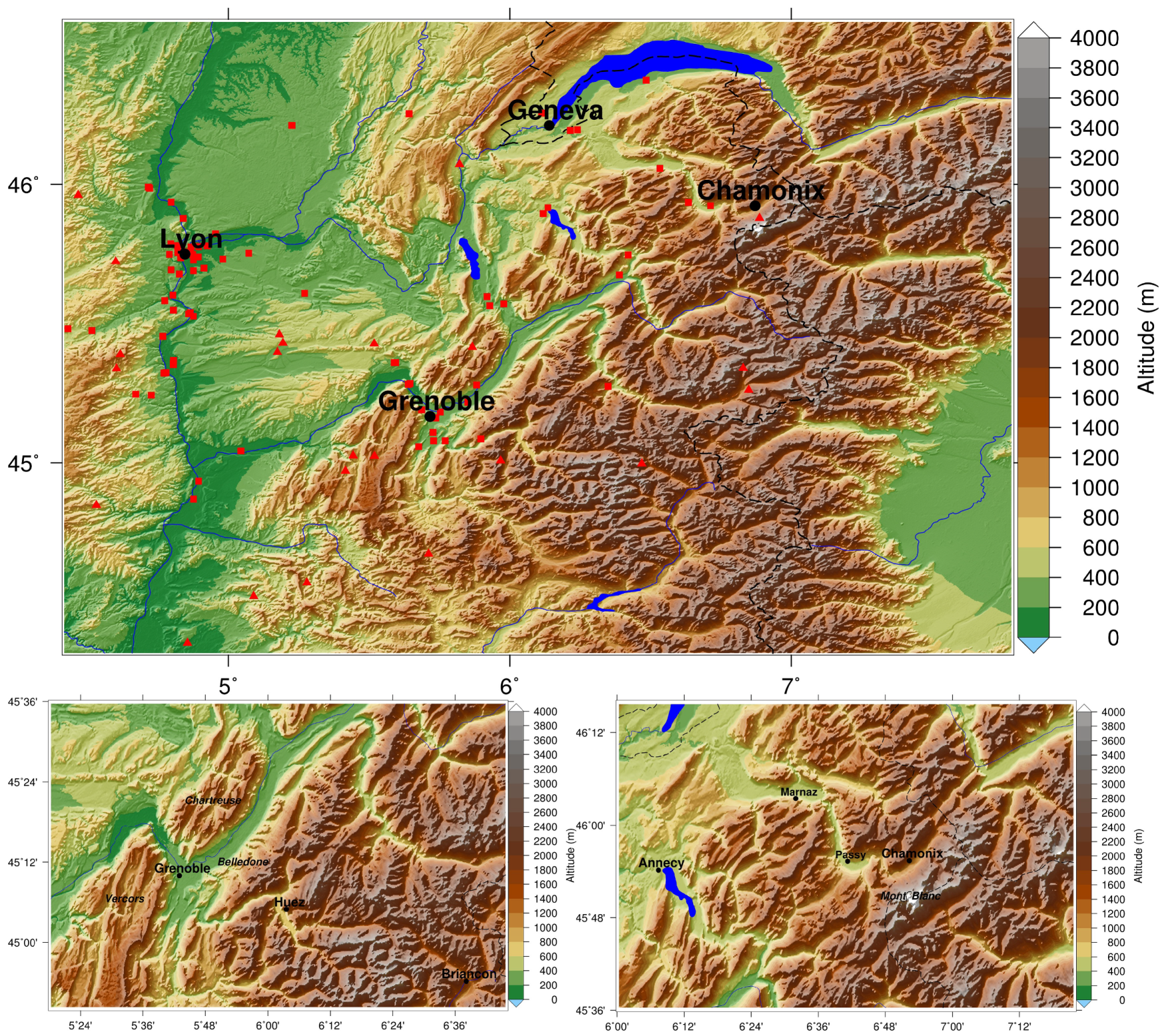
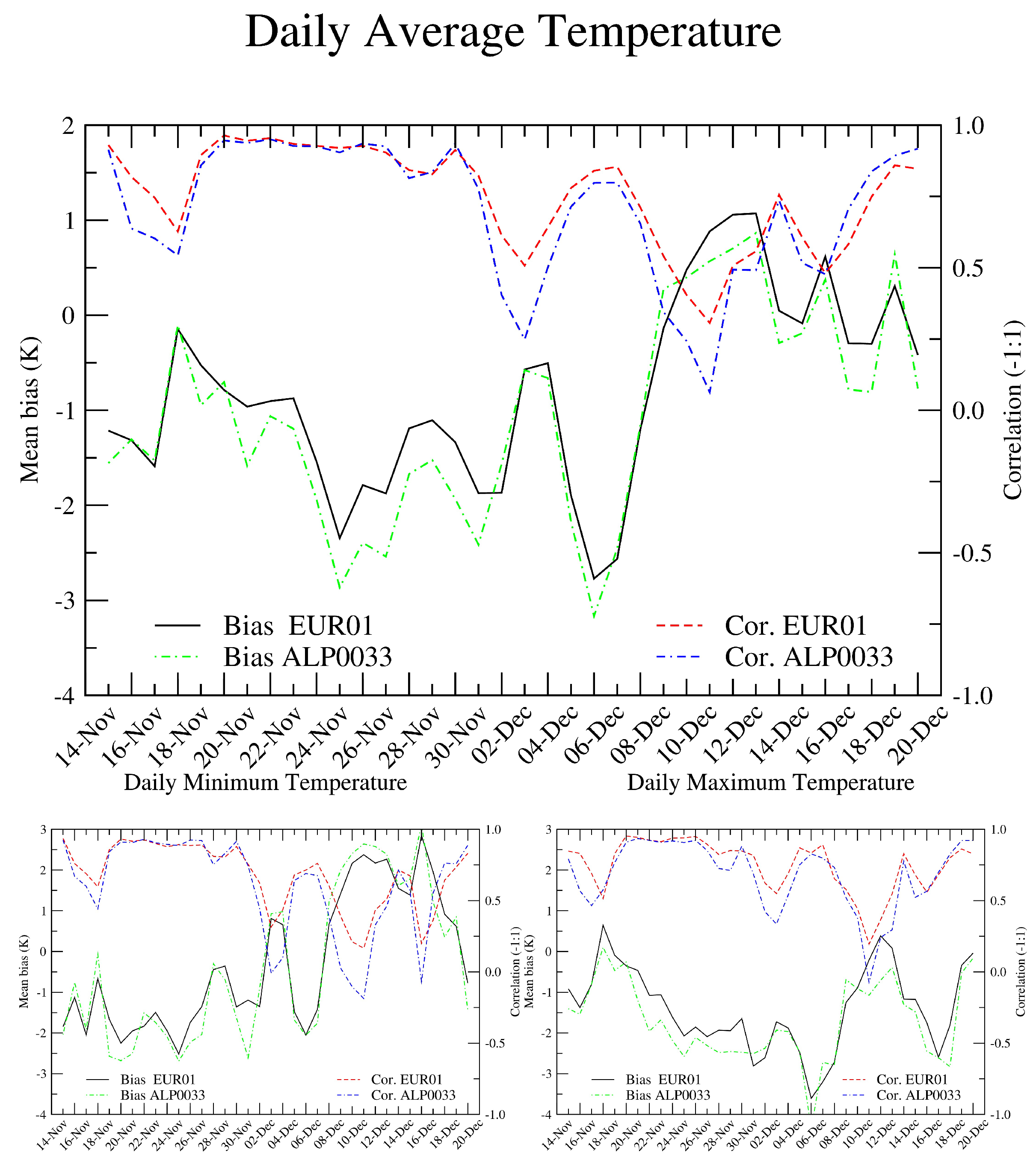

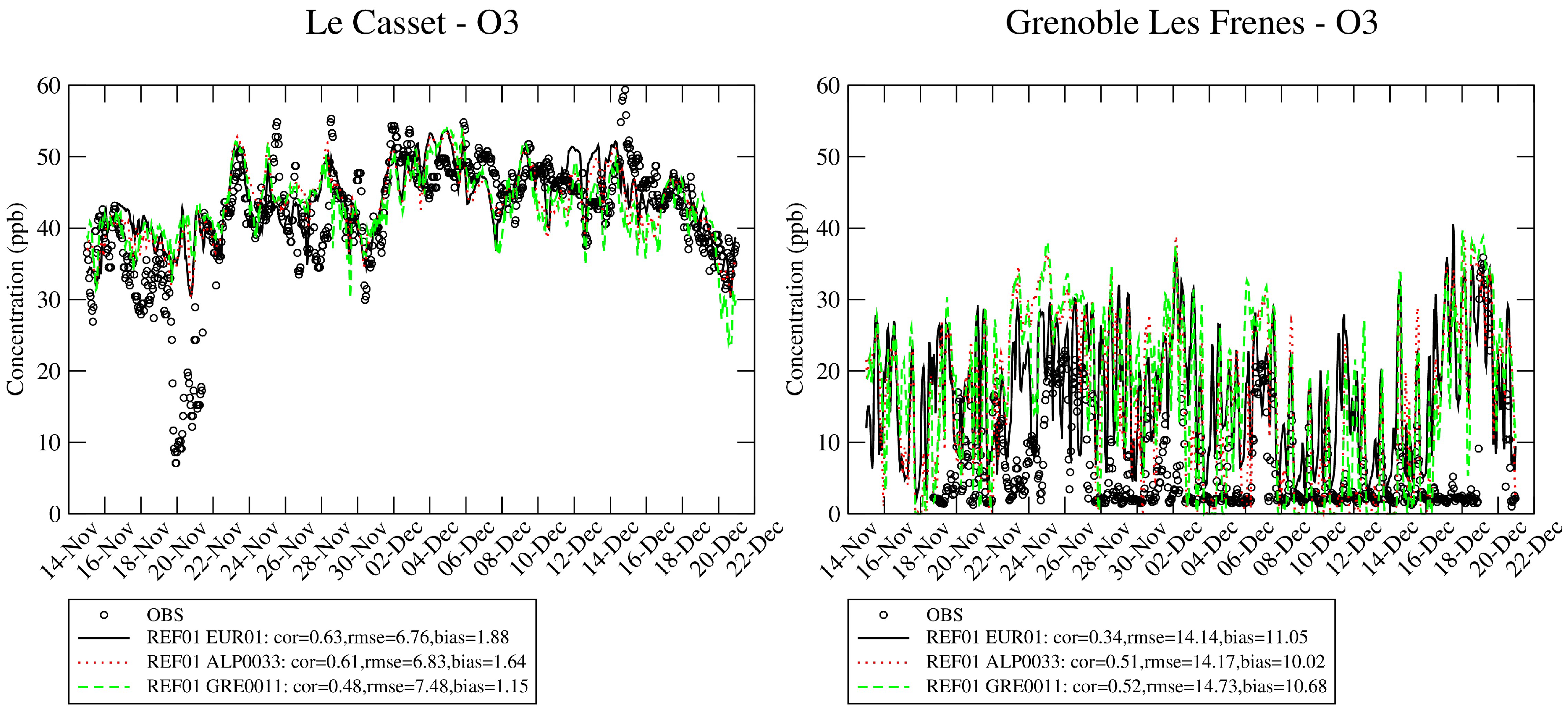
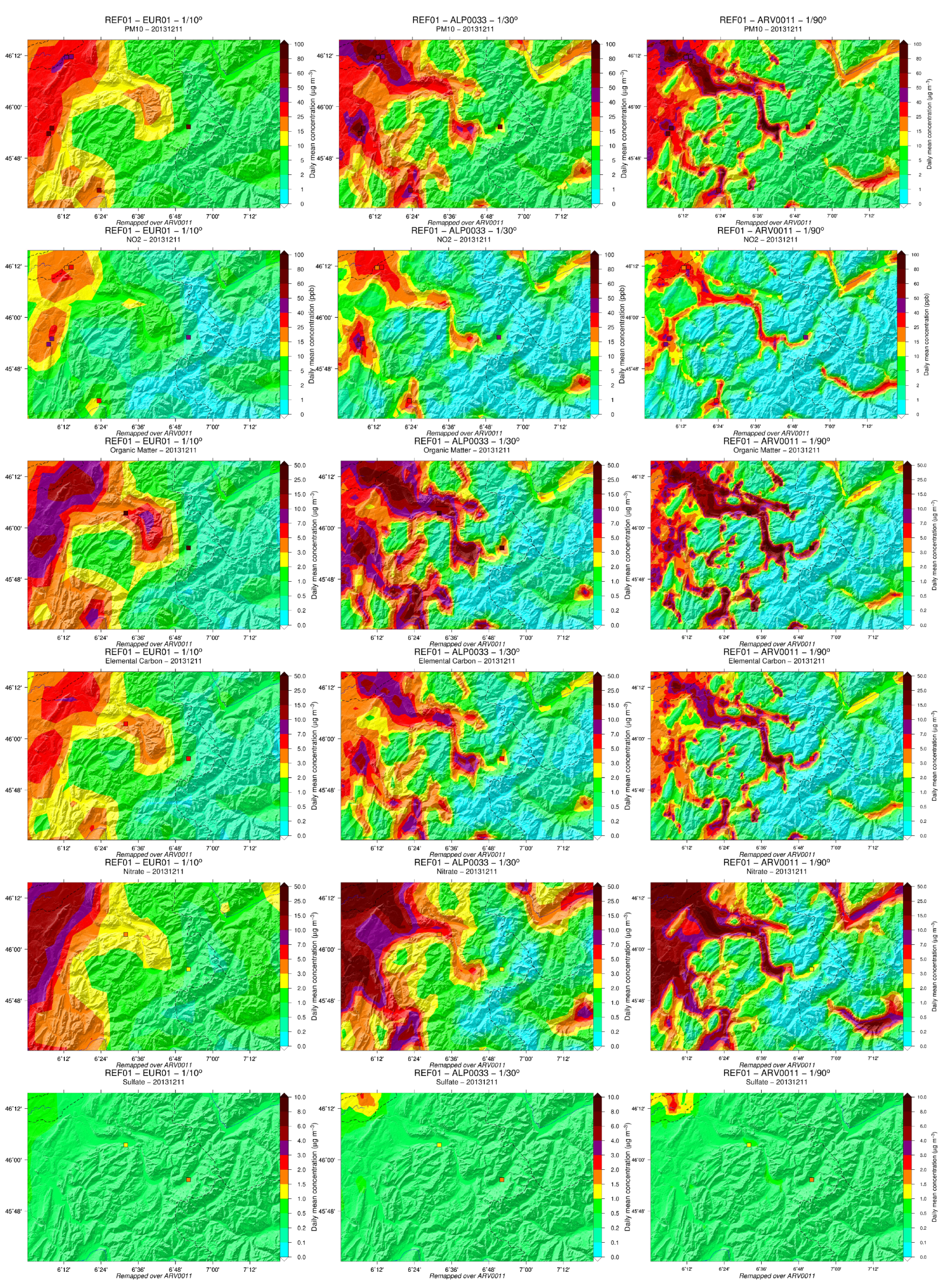


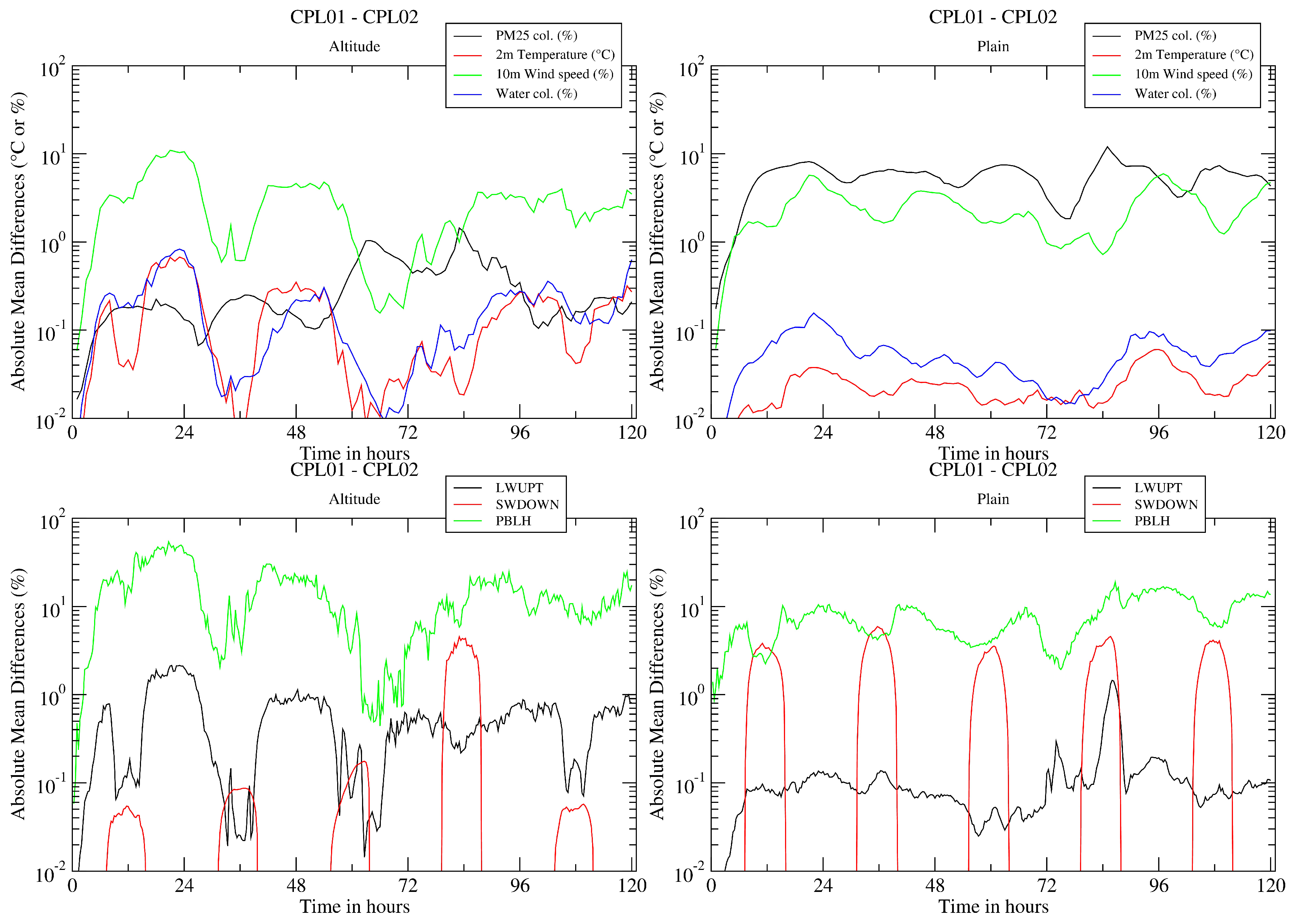
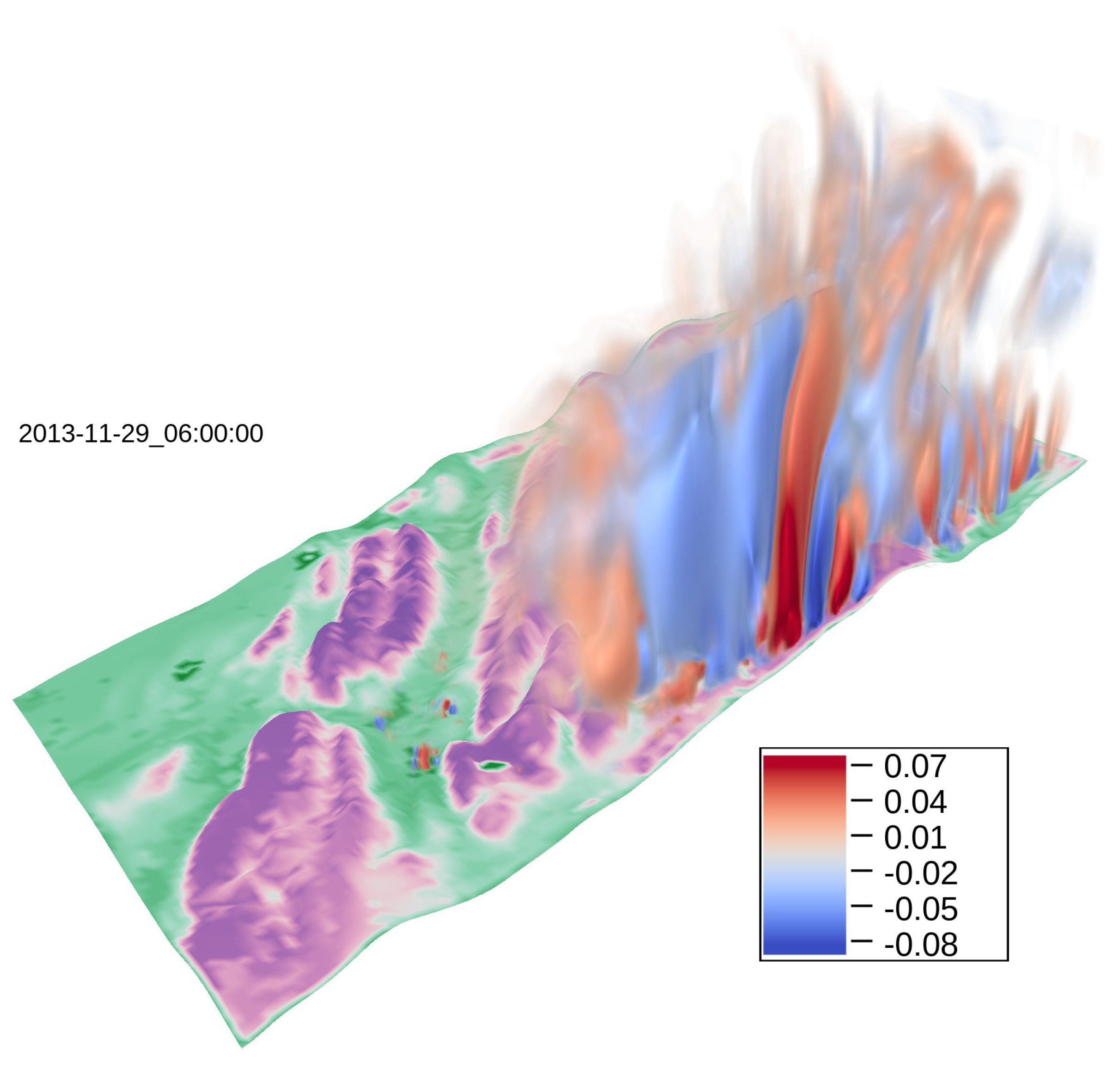

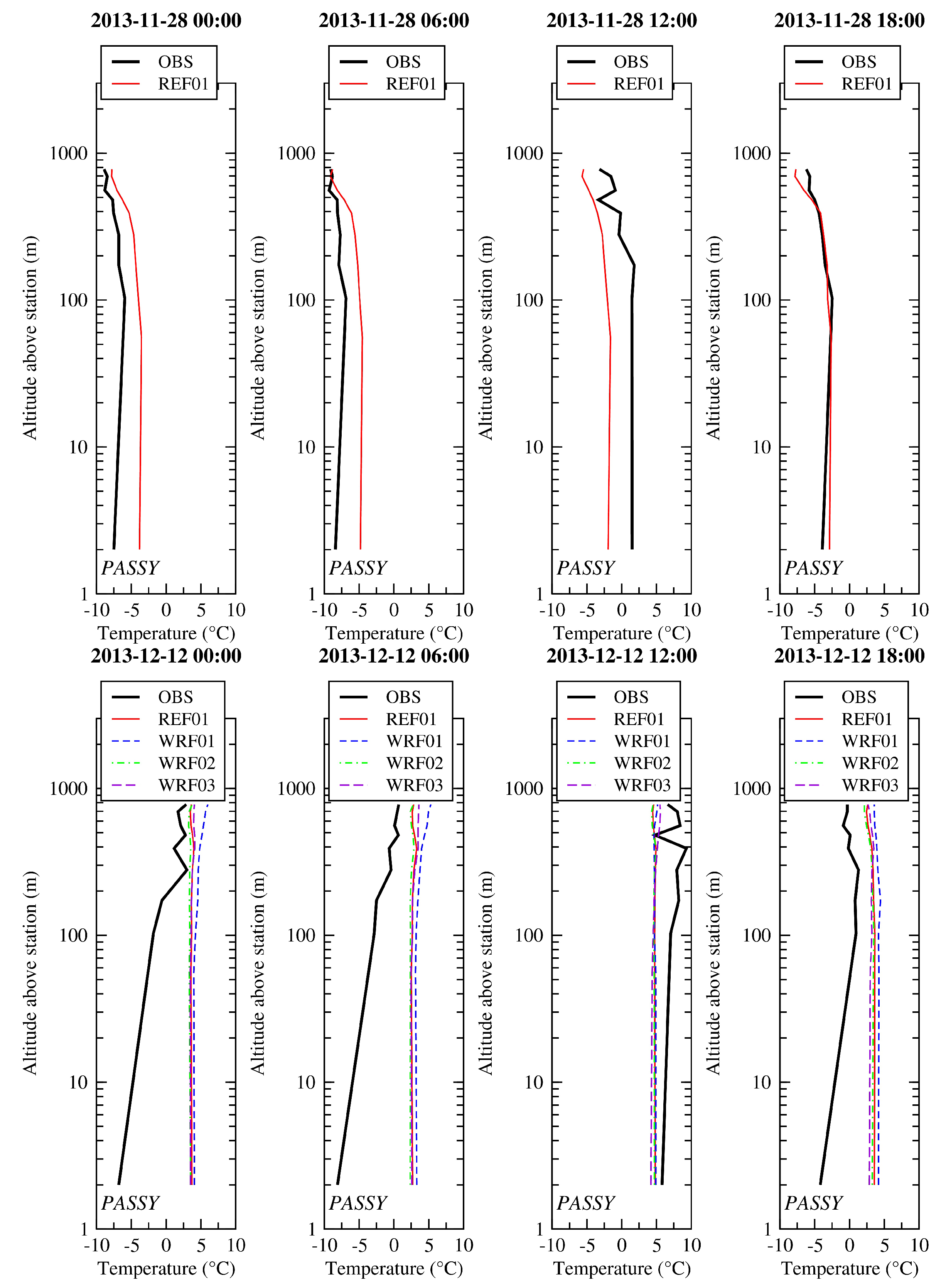
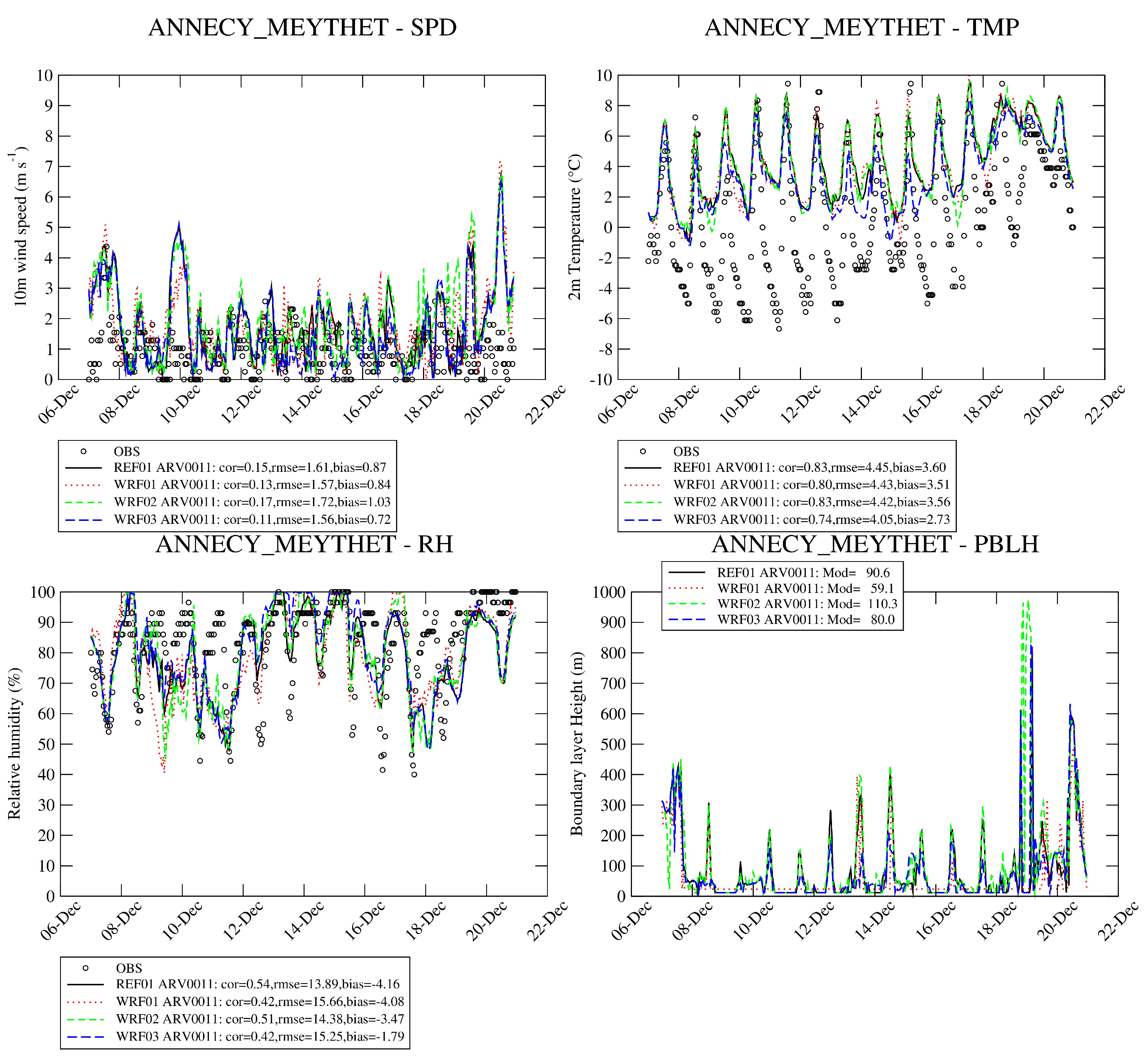

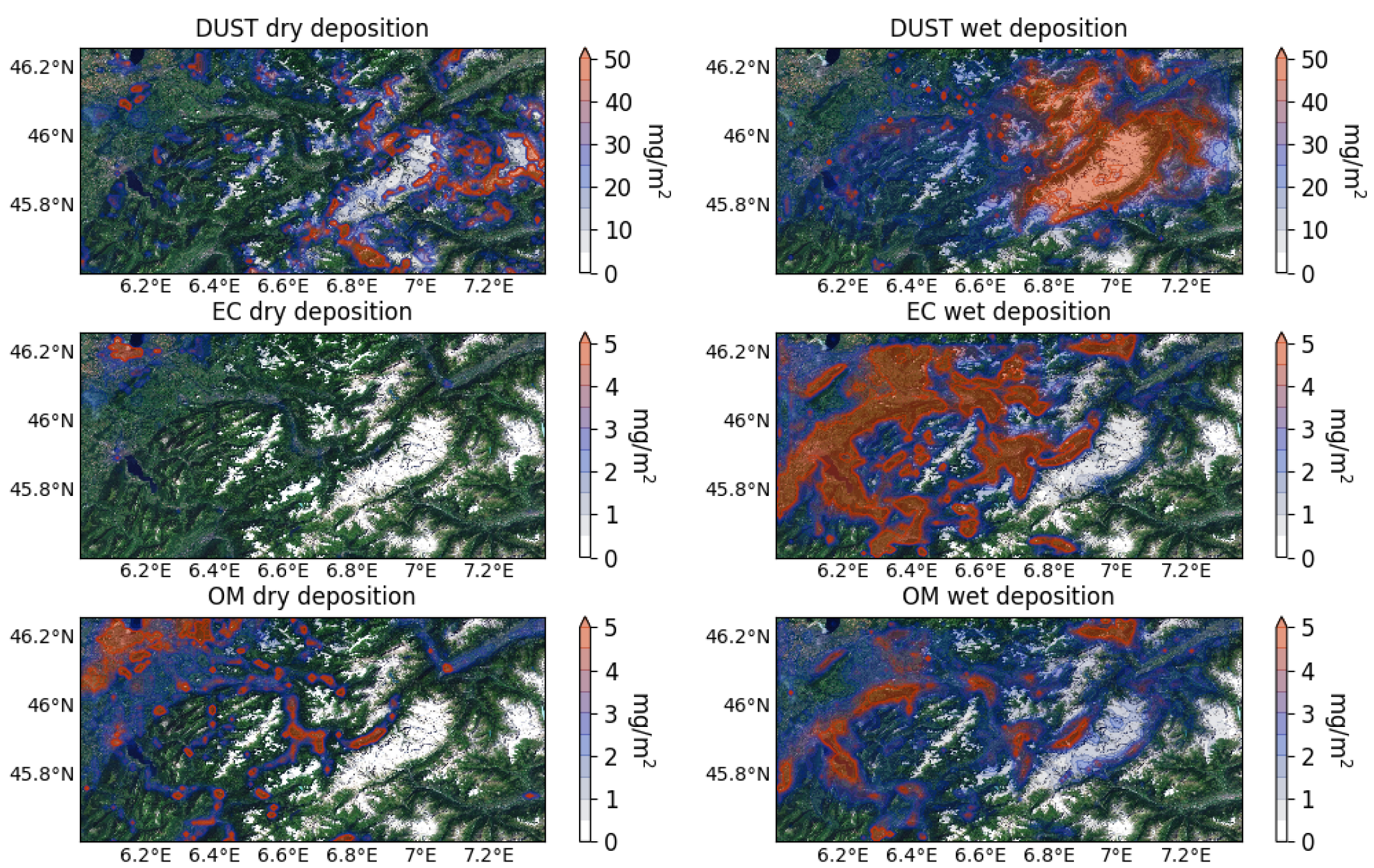
| WRF Option | Number | Scheme Name |
|---|---|---|
| mp_physics | 8 | Thompson graupel [32] |
| ra_lw_physics | 4 | Rapid Radiative Transfer Model (RRTMG, [33]) |
| ra_sw_physics | 4 | RRTMG |
| sf_sfclay_physics | 1 | MOS—Monin-Obukhov Similarity [34,35] |
| sf_surface_physics | 2 | Noah Land-Surface |
| sf_urban_physics | 0 | No urban canopy |
| bl_pbl_physics | 1 | YSU (Yonsei University, [36]) |
| cu_physics | 2 | Grell-Devenyi ensemble (only for the coarse domain) [37] |
| aer_opt | 0 | No direct aerosol radiative effect |
| diff_opt | 2 | Evaluates mixing terms in physical space (stress form) (x,y,z). Turbulence parameterization is chosen by specifying km_opt |
| km_opt | 4 | Horizontal Smagorinsky first order closure (recommended for real-data case). K for horizontal diffusion is diagnosed from just horizontal deformation. The vertical diffusion is assumed to be done by the PBL scheme (2D) |
| diff_6th_opt | 0 | No 6th-order diffusion |
| Domain Name | EUR01 | ALP0033 | GRE0011 | ARV0011 |
|---|---|---|---|---|
| Area | Western Europe | French Alps | Grenoble | Arve Valley |
| Coverage | 11.85 W–33.25 N/33.85 E–60.85 N | 4.417 E–44.317 N/7.783 E–46.583 N | 5.305 E–44.839 N/6.761 E–45.594 N | 6.005 E–45.605 N/7.361 E–46.261 N |
| Number of grid points | 459 × 278 | 103 × 70 | 133 × 70 | 124 × 61 |
| Resolution | ||||
| Number of CHIMERE levels | 15 | 20 | 20 | 20 |
| Chemical BOUN-INIT | LMDzINCA GOCART | EUR01 | ALP0033 | ALP0033 |
| Met. BOUN-INIT | NCEP/GFS | EUR01 | ALP0033 | ALP0033 |
| Met. Nudging | Yes | No | No | No |
| Station Code | Station Name | Country Code | Longitude () | Latitude () | Altitude (m) |
|---|---|---|---|---|---|
| LFLS | GRENOBLE ST.-GEO | FR | 5.317 | 45.367 | 386 |
| VERS | GRENOBLE LE VERSOUD | FR | 5.849 | 45.217 | 220 |
| LFLB | CHAMBERY AIX-BAI | FR | 5.867 | 45.633 | 239 |
| LFLP | ANNECY MEYTHET | FR | 6.083 | 45.917 | 463 |
| Station Code | Station Name | Longitude () | Latitude () | Altitude (m) | Typology |
|---|---|---|---|---|---|
| FR15043 * | Grenoble Les Frenes | 5.736 | 45.162 | 214 | Urban |
| FR15111 | Chartreuse | 5.867 | 45.416 | 860 | Rural |
| FR15031 | Le Casset | 6.469 | 44.997 | 1750 | Rural |
| FR20062 | LYON Centre | 4.854 | 45.758 | 160 | Urban |
| FR33101 | PASTEUR | 5.928 | 45.565 | 280 | Urban |
| FR33102 | CHAMBERY LE HAUT | 5.919 | 45.597 | 383 | Urban |
| FR33120 * | CHAMONIX | 6.870 | 45.922 | 1035 | Urban |
| FR33212 | GAILLARD | 6.215 | 46.193 | 426 | Urban |
| FR33220 * | PASSY | 6.714 | 45.924 | 583 | Suburban |
| FR33211 | ANNEMASSE | 6.241 | 46.196 | 441 | Urban |
| FR33367 * | MARNAZ | 6.533 | 46.058 | 505 | Suburban |
| Name of the Simulation | Domains | Periods | Description |
|---|---|---|---|
| REF01 | All domains | 15/November– 20/December | As presented in the “Model Set-up” section |
| CPL01 | ALP033, GRE0011 | 27–30/November | Activation of on-line coupling (cpl_case=4) in the CHIMERE namelist |
| CPL02 | ALP033, GRE0011 | 27–30/November | Activation of on-line coupling (cpl_case=4) in the CHIMERE namelist and Residential PM emissions switched off |
| WRF01 | ALP033, GRE0011, ARV0011 | 7–20/December | diff_opt=0, MYJ scheme for the PBL (bl_pbl_physics=2), Monin-Obukhov (Janjic Eta) Similarity scheme (sf_sfclay_physics=2) |
| WRF02 | ALP033, ARV0011 | 7–20/December | diff_opt=0 |
| WRF03 | ALP033, ARV0011 | 7–20/December | slope_rad=1, topo_shading=1 |
| Species | Domain | Obs. | Mod. | Bias | RMSE | R | Sample |
|---|---|---|---|---|---|---|---|
| PM10 | EUR01 | 3.44 | 15.35 | −18.09 | 22.42 | 0.56 | 272 |
| ALP0033 | 19.00 | −14.44 | 19.93 | 0.59 | |||
| GRE0011 | 19.47 | −13.97 | 20.61 | 0.55 | |||
| PM2.5 | EUR01 | 28.74 | 18.92 | −9.82 | 14.56 | 0.58 | 67 |
| ALP0033 | 20.88 | −7.86 | 15.87 | 0.57 | |||
| GRE0011 | 21.38 | −7.36 | 19.17 | 0.48 | |||
| NO | EUR01 | 18.65 | 10.68 | −7.97 | 10.77 | 0.52 | 341 |
| ALP0033 | 13.43 | −5.22 | 10.75 | 0.53 | |||
| GRE0011 | 13.26 | −5.39 | 10.86 | 0.54 | |||
| Nitrate | EUR01 | 3.92 | 5.38 | 1.45 | 2.76 | 0.78 | 12 |
| ALP0033 | 6.36 | 2.44 | 7.17 | 0.26 | |||
| GRE0011 | 7.77 | 3.85 | 8.66 | 0.32 | |||
| Sulfate | EUR01 | 1.60 | 0.77 | −0.83 | 1.01 | 0.51 | 12 |
| ALP0033 | 0.77 | −0.83 | 1.00 | 0.58 | |||
| GRE0011 | 0.79 | −0.81 | 0.95 | 0.69 | |||
| Ammonium | EUR01 | 1.30 | 1.81 | 0.51 | 0.91 | 0.77 | 12 |
| ALP0033 | 2.03 | 0.72 | 2.10 | 0.21 | |||
| GRE0011 | 2.50 | 1.19 | 2.61 | 0.27 | |||
| OM | EUR01 | 13.73 | 5.58 | −8.15 | 10.60 | 0.78 | 12 |
| ALP0033 | 7.31 | −6.42 | 7.98 | 0.85 | |||
| GRE0011 | 8.99 | −4.73 | 7.30 | 0.83 | |||
| EC | EUR01 | 3.09 | 3.91 | 0.82 | 1.71 | 0.82 | 12 |
| ALP0033 | 5.56 | 2.48 | 3.72 | 0.88 | |||
| GRE0011 | 6.82 | 3.74 | 6.05 | 0.83 | |||
| DUST | EUR01 | 2.88 | 1.19 | −1.69 | 2.11 | 0.78 | 12 |
| ALP0033 | 1.34 | −1.53 | 1.98 | 0.76 | |||
| GRE0011 | 1.39 | −1.48 | 1.94 | 0.77 | |||
| Sodium | EUR01 | 0.18 | 0.05 | −0.13 | 0.18 | 0.57 | 12 |
| ALP0033 | 0.04 | −0.14 | 0.19 | 0.53 | |||
| GRE0011 | 0.04 | −0.14 | 0.19 | 0.65 |
| Species | Domain | Obs. | Mod. | Bias | RMSE | R | Sample |
|---|---|---|---|---|---|---|---|
| PM10 | EUR01 | 39.44 | 12.85 | −26.59 | 33.74 | 0.39 | 224 |
| ALP0033 | 18.80 | −20.65 | 27.32 | 0.61 | |||
| ARV0011 | 23.04 | −16.41 | 24.06 | 0.65 | |||
| PM2.5 | EUR01 | 29.98 | 16.08 | −13.90 | 18.07 | 0.68 | 99 |
| ALP0033 | 20.03 | −9.95 | 15.46 | 0.71 | |||
| ARV0011 | 17.73 | −12.25 | 17.24 | 0.68 | |||
| NO | EUR01 | 23.51 | 9.05 | −14.46 | 18.36 | 0.15 | 198 |
| ALP0033 | 15.58 | −7.93 | 14.38 | 0.37 | |||
| ARV0011 | 15.67 | −7.85 | 12.16 | 0.57 | |||
| Nitrate | EUR01 | 3.74 | 1.48 | −2.26 | 3.40 | 0.46 | 47 |
| ALP0033 | 2.99 | −0.75 | 3.49 | 0.45 | |||
| ARV0011 | 5.03 | 1.29 | 5.13 | 0.27 | |||
| Sulfate | EUR01 | 1.69 | 0.43 | −1.26 | 1.50 | 0.29 | 47 |
| ALP0033 | 0.54 | −1.15 | 1.41 | 0.29 | |||
| ARV0011 | 0.69 | −1.00 | 1.24 | 0.50 | |||
| Ammonium | EUR01 | 1.42 | 0.57 | −0.85 | 1.21 | 0.50 | 47 |
| ALP0033 | 1.05 | −0.37 | 1.08 | 0.53 | |||
| ARV0011 | 1.68 | 0.26 | 1.42 | 0.41 | |||
| OM | EUR01 | 30.47 | 2.75 | −27.73 | 32.85 | 0.45 | 47 |
| ALP0033 | 7.06 | −23.41 | 27.92 | 0.68 | |||
| ARV0011 | 12.77 | −17.70 | 23.43 | 0.56 | |||
| EC | EUR01 | 4.95 | 1.65 | −3.29 | 4.70 | 0.31 | 47 |
| ALP0033 | 3.91 | −1.04 | 3.60 | 0.43 | |||
| ARV0011 | 6.68 | 1.74 | 4.87 | 0.48 | |||
| DUST | EUR01 | 2.25 | 1.33 | −0.92 | 2.07 | 0.34 | 47 |
| ALP0033 | 1.49 | −0.76 | 1.94 | 0.41 | |||
| ARV0011 | 1.60 | −0.64 | 1.89 | 0.42 | |||
| Sodium | EUR01 | 0.18 | 0.03 | −0.16 | 0.28 | 0.10 | 46 |
| ALP0033 | 0.03 | −0.16 | 0.28 | 0.09 | |||
| ARV0011 | 0.03 | −0.16 | 0.28 | 0.10 |
| Domain | Species | |||
|---|---|---|---|---|
| GRE0011 | EC | 99.6 | 104.6 | 107.9 |
| Nitrate | 299.1 | 298.6 | 312.3 | |
| ARV0011 | EC | 66.8 | 71.7 | 75.1 |
| Nitrate | 187.8 | 213.5 | 222.6 |
| Variable | Simulation | Condition | ALP0033— | GRE0011— |
|---|---|---|---|---|
| TMP (C) | REF01 | PM10 > 10 g m | −3.71 | −3.16 |
| PM10 < 10 g m | −10.87 | −10.91 | ||
| CPL01 | PM10 > 10 g m | −3.77 | −3.23 | |
| PM10 < 10 g m | −10.88 | −10.92 | ||
| CPL02 | PM10 > 10 g m | −3.77 | −3.23 | |
| PM10 < 10 g m | −10.88 | −10.92 | ||
| LWC (kton day) | REF01 | PM10 > 10 g m | 166.2 | 106.4 |
| PM10 < 10 g m | 125.9 | 106.1 | ||
| CPL01 | PM10 > 10 g m | 176.0 | 112.5 | |
| PM10 < 10 g m | 141.1 | 122.1 | ||
| CPL02 | PM10 > 10 g m | 176.0 | 112.5 | |
| PM10 < 10 g m | 140.4 | 121.7 | ||
| KZZ (m s) | REF01 | PM10 > 10 g m | 0.827 | 1.548 |
| PM10 < 10 g m | 0.380 | 0.509 | ||
| CPL01 | PM10 > 10 g m | 0.738 | 1.436 | |
| PM10 < 10 g m | 0.370 | 0.503 | ||
| CPL02 | PM10 > 10 g m | 0.746 | 1.456 | |
| PM10 < 10 g m | 0.370 | 0.504 |
| Variable | REF01 | WRF01 | WRF02 | WRF03 |
|---|---|---|---|---|
| TMP (C) | 4.69 | 4.63 | 4.56 | 4.42 |
| KZZ (m s) | 0.35 | 0.17 | 0.34 | 0.26 |
| PBL (m) | 47.4 | 28.4 | 50.1 | 40.1 |
| LWC (kton.day) | 34 | 56 | 61 | 75 |
© 2020 by the authors. Licensee MDPI, Basel, Switzerland. This article is an open access article distributed under the terms and conditions of the Creative Commons Attribution (CC BY) license (http://creativecommons.org/licenses/by/4.0/).
Share and Cite
Bessagnet, B.; Menut, L.; Lapere, R.; Couvidat, F.; Jaffrezo, J.-L.; Mailler, S.; Favez, O.; Pennel, R.; Siour, G. High Resolution Chemistry Transport Modeling with the On-Line CHIMERE-WRF Model over the French Alps—Analysis of a Feedback of Surface Particulate Matter Concentrations on Mountain Meteorology. Atmosphere 2020, 11, 565. https://doi.org/10.3390/atmos11060565
Bessagnet B, Menut L, Lapere R, Couvidat F, Jaffrezo J-L, Mailler S, Favez O, Pennel R, Siour G. High Resolution Chemistry Transport Modeling with the On-Line CHIMERE-WRF Model over the French Alps—Analysis of a Feedback of Surface Particulate Matter Concentrations on Mountain Meteorology. Atmosphere. 2020; 11(6):565. https://doi.org/10.3390/atmos11060565
Chicago/Turabian StyleBessagnet, Bertrand, Laurent Menut, Rémy Lapere, Florian Couvidat, Jean-Luc Jaffrezo, Sylvain Mailler, Olivier Favez, Romain Pennel, and Guillaume Siour. 2020. "High Resolution Chemistry Transport Modeling with the On-Line CHIMERE-WRF Model over the French Alps—Analysis of a Feedback of Surface Particulate Matter Concentrations on Mountain Meteorology" Atmosphere 11, no. 6: 565. https://doi.org/10.3390/atmos11060565
APA StyleBessagnet, B., Menut, L., Lapere, R., Couvidat, F., Jaffrezo, J.-L., Mailler, S., Favez, O., Pennel, R., & Siour, G. (2020). High Resolution Chemistry Transport Modeling with the On-Line CHIMERE-WRF Model over the French Alps—Analysis of a Feedback of Surface Particulate Matter Concentrations on Mountain Meteorology. Atmosphere, 11(6), 565. https://doi.org/10.3390/atmos11060565








